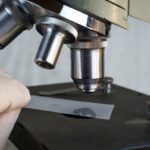The realm of biology is a vast and complex field, exploring the intricacies of life from the smallest microorganisms to the largest ecosystems. Within this discipline, one aspect that often intrigues scientists and laymen alike is the concept of ‘hardness’. In biological terms, ‘hardness’ refers to the structural strength and durability of certain parts of an organism. This article aims to delve into this fascinating aspect of biology, focusing particularly on tooth enamel, the hardest substance in the human body, and exploring other hard structures in various organisms.
Brief Overview of Biology
Biology, as a scientific discipline, encompasses the study of life and living organisms. It is a broad field, divided into numerous sub-disciplines, each focusing on different aspects of life, from the molecular level to the biosphere. From genetics to ecology, from anatomy to zoology, biology offers a comprehensive understanding of life in all its forms and functions.
Understanding the Concept of ‘Hardest’ in Biology
In the context of biology, ‘hardest’ does not merely refer to physical hardness, but also to the structural resilience and durability of biological materials. These materials, often mineralized tissues, play crucial roles in the survival and adaptation of organisms, offering protection, support, and functionality.
The Intricacies of Tooth Enamel
Tooth enamel, a highly mineralized substance, holds the title of being the hardest tissue in the human body. Its hardness surpasses that of any other human tissue, including bone.
Composition and Structure of Tooth Enamel
Tooth enamel is primarily composed of hydroxyapatite, a crystalline calcium phosphate. This mineral accounts for over 95% of the enamel’s volume, making it highly resistant to wear and tear. The remaining composition includes water and organic material. Structurally, enamel is formed by tightly packed rods or prisms, each containing millions of hydroxyapatite crystals.
Why Tooth Enamel is Considered the Hardest Part of the Body
The exceptional hardness of tooth enamel is attributed to its high mineral content and its unique structural organization. The densely packed hydroxyapatite crystals provide a level of hardness that is unmatched by any other tissue in the human body. This hardness enables the teeth to withstand the mechanical stresses of chewing and biting, protecting the sensitive inner parts of the tooth.
The Role of Tooth Enamel in Human Biology
Tooth enamel serves a critical function in human biology. Its hardness and durability enable it to act as a protective barrier for the underlying dentin and pulp, shielding them from physical damage and bacterial invasion. Moreover, enamel plays a vital role in the process of mastication, facilitating the breakdown of food for digestion.
Other Hard Structures in the Human Body
While tooth enamel holds the title for the hardest tissue, other structures in the human body also exhibit considerable hardness. These include bones, nails, and hair, each with their unique composition and function.
Bones: The Framework of the Body
Bones, composed primarily of calcium phosphate in the form of hydroxyapatite, provide the structural framework for the human body. They offer support, facilitate movement, and protect vital organs. Despite being less hard than tooth enamel, bones exhibit remarkable strength and resilience, thanks to their composite structure of mineralized and organic components.
Nails and Hair: Keratin-Based Hard Structures
Nails and hair, unlike bones and teeth, are composed of keratin, a type of protein. The hardness of these structures is attributed to the high sulfur content in keratin, which forms strong disulfide bonds. While not as hard as enamel or bone, nails and hair provide protection and sensory functions.
Comparative Analysis: Tooth Enamel vs. Other Hard Structures
When compared to other hard structures in the human body, tooth enamel stands out for its exceptional hardness. However, each of these structures, whether it’s the resilient bones or the protective nails and hair, plays a crucial role in human biology, contributing to the body’s overall functionality and survival.
Hard Structures in Other Organisms
Beyond the human body, nature presents a plethora of hard structures in various organisms, each with unique compositions and functions.
Exoskeletons in Arthropods
Arthropods, including insects, spiders, and crustaceans, possess hard exoskeletons made of chitin, a complex polysaccharide. These exoskeletons provide protection, support, and facilitate movement.
Shells in Mollusks
Mollusks, such as snails and clams, are known for their hard shells. These shells, composed primarily of calcium carbonate, serve as a protective armor against predators and environmental hazards.
Scales in Fish and Reptiles
Fish and reptiles are characterized by their hard scales, which offer protection and aid in locomotion. The composition of these scales varies among species, ranging from keratin in reptiles to mineralized structures in fish.
The Biological Process of Hardening
The formation of hard structures in biology is a complex process, involving intricate biochemical pathways and environmental influences.
Biomineralization: The Process Behind Hard Structures
Biomineralization is the process by which living organisms produce minerals, often to harden or stiffen existing tissues. This process is responsible for the formation of hard structures like tooth enamel, bones, and shells. It involves the deposition of mineral ions into an organic matrix, resulting in a composite material with enhanced hardness and resilience.
The Role of Genes in Hard Structure Formation
Genes play a crucial role in the formation of hard structures. They regulate the expression of proteins involved in biomineralization, influencing the composition, structure, and properties of the resulting hard tissue.
The Impact of Diet and Environment on Hardening
Diet and environment also significantly impact the formation and properties of hard structures. For instance, a diet rich in calcium and phosphate is essential for the formation of hard tissues like enamel and bone. Similarly, environmental factors such as temperature and pH can influence the process of biomineralization.
Challenges in Studying Hard Structures in Biology
Despite the advancements in biological research, studying hard structures presents several challenges.
Technological Limitations
One of the main challenges is the technological limitations in analyzing hard tissues at the molecular and nano-scale levels. Advanced techniques like electron microscopy and X-ray diffraction are often required, which can be expensive and technically demanding.
Ethical Considerations
Ethical considerations also pose a challenge, particularly when studying hard structures in humans. Invasive procedures are often required to obtain samples, raising ethical concerns.
The Complexity of Biological Systems
The complexity of biological systems adds another layer of difficulty. The formation and properties of hard structures are influenced by a multitude of factors, from genetic to environmental, making it challenging to isolate and study individual factors.
The Importance of Hard Structures in Evolution
Hard structures have played a pivotal role in the evolution of life on Earth, contributing to the survival and adaptation of organisms across diverse environments.
Survival and Adaptation: The Role of Hard Structures
Hard structures offer protection, support, and functionality, enabling organisms to survive and thrive in various environments. For instance, the hard shells of mollusks protect them from predators, while the hard exoskeletons of arthropods provide support and facilitate movement.
Hard Structures as Evolutionary Markers
Hard structures also serve as valuable evolutionary markers. They are often well-preserved in the fossil record, providing insights into the evolutionary history and phylogenetic relationships of organisms.
The Future of Hard Structures: Predictions and Possibilities
As we continue to unravel the mysteries of hard structures in biology, we can expect to uncover new insights and possibilities. These could range from the development of bio-inspired materials and technologies, to a deeper understanding of evolutionary processes and the biology of life itself.
In conclusion
The study of hard structures in biology offers a fascinating glimpse into the complexity and diversity of life. From the hardest tooth enamel in humans to the protective shells of mollusks, these structures play crucial roles in the survival and adaptation of organisms. Understanding these structures not only enriches our knowledge of biology but also holds potential for practical applications, from biomimetic materials to medical advancements.
Frequently Asked Questions
What is the hardest part of the human body?
The hardest part of the human body is the tooth enamel, which is primarily composed of hydroxyapatite, a crystalline calcium phosphate.
How does tooth enamel compare to other hard structures in the body?
Tooth enamel is harder than any other tissue in the human body, including bone. Its high mineral content and unique structural organization give it exceptional hardness and durability.
What are some examples of hard structures in other organisms?
Examples of hard structures in other organisms include the chitin-based exoskeletons in arthropods, calcium carbonate shells in mollusks, and keratin or mineralized scales in fish and reptiles.
What is biomineralization?
Biomineralization is the process by which living organisms produce minerals, often to harden or stiffen existing tissues. This process is responsible for the formation of hard structures like tooth enamel, bones, and shells.
What challenges are faced in studying hard structures in biology?
Challenges in studying hard structures in biology include technological limitations in analyzing hard tissues at the molecular and nano-scale levels, ethical considerations in obtaining samples, and the complexity of biological systems that influence the formation and properties of hard structures.
Why are hard structures important in evolution?
Hard structures are important in evolution as they contribute to the survival and adaptation of organisms across diverse environments. They also serve as valuable evolutionary markers, providing insights into the evolutionary history and phylogenetic relationships of organisms.
References:
- Hillson, S. (2005). Teeth. Cambridge University Press.
- Lowenstam, H. A., & Weiner, S. (1989). On Biomineralization. Oxford University Press.
- Simkiss, K., & Wilbur, K. M. (1989). Biomineralization: Cell Biology and Mineral Deposition. Academic Press.
- Wysokinski, M., Chapman, D., Adams, F., & Zhong, Z. (2010). Hard X-ray imaging of bacterial cells: nano-diffraction and ptychographic reconstruction. Optics Express, 20(17), 19232-19238.







